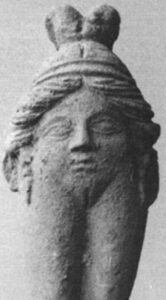IMLR Sylvia Naish Fellow, Frederika Tevebring, discusses Freud’s parallels between archaeology and psychoanalysis. Special Issue of American Imago, vol. 78, no.2 (Summer 2021)
In the summer of 2019 the Warburg Institute, in collaboration with the University of Chicago and the Freud Museum, hosted the conference “Freud’s Archaeology,” exploring Freud’s self-proclaimed “obsession” with antiquity and the importance of archaeology in his conceptualisation of psychoanalysis. From this event, a special issue was conceived that will appear in American Imago.
Freud’s library, as well as his own texts, are replete with references to excavation, buried cities, and to the works of archaeologists and philologists. Following his father’s death in 1896 he became an avid collector and began to crowd his office and consulting room with archaeological objects. His favourite statuettes – fondly referred to as his “old grubby gods” – were arranged in neat rows on his desk so that they could gaze over him when he was writing. His collection never spilled over from his working space into the family’s living room and, similarly, his regular trips to Italy were undertaken with colleagues (or his brother) rather than in the company of wife and children. Freud’s relation to the ancient Mediterranean was deeply personal, but linked to his identity as the founder of a new science. The work of archaeology and psychoanalysis, he insisted, was in fact “identical.”

Figure 1 so-called Baubo statuette. Terracotta votive from Priene, modern-day Turkey. Excavated in 1898. Berlin Antikensammlung
For Freud, psychoanalysis and archaeology both share the task of retrieving memories out of sedimented depths and incorporating these memories into the present. This parallel is often glossed as a “metaphor,” perhaps most famously in Donald Kuspit’s 1989 essay on archaeology as the “mighty metaphor” of Freud’s work. “Metaphor,” however, simplifies the unique ways that Freud deploys likenesses and parallels in his writing. A metaphor is commonly understood as an illustrative comparison between something well-known and something lesser known. Freud, however, often insists on identity rather than comparison. Moreover, when he presents us with parallels such as an “exact correspondence” between the relatively recently excavated “Baubo” figurines (Figure 1) and his patient’s Oedipally-informed visual obsession (“A Mythological Parallel to a Visual Obsession,” 1916), we can no longer be certain which of the pair is supposed to be the well-known, and which the lesser-known example. Is archaeology elucidating psychoanalysis or the other way around?
In Freud’s Archaeology, the authors’ backgrounds in archaeology, classics, art history, and German literature shift the focus away from treating archaeology as a self-explanatory practice; instead, these diverse perspectives help to situate Freud’s interest within the history of the discipline, his intellectual milieu, and geopolitical circumstances. Like any of his bourgeois contemporaries, Freud received an education with a strong foundation in classical literature and would have been introduced early to the idea of Greece and Rome as the “childhood” of modern European culture. Freud’s archaeology is hence, without a doubt, a Eurocentric one: it excavates the biography of the – implicitly male – European subject who has claimed the classical past as his heritage. Archaeology had developed hand-in-hand with European colonial interests and took for granted that Europeans were best positioned to explore and safe keep the heritage of the world. Neither is Freud particularly interested in the discoveries of prehistoric central Europe. The archaeology he refers to is undertaken in exotic locations by larger-than-life personalities – such as Howard Carter or Heinrich Schliemann – to the admiration and media attention of the nation back home.
However, while Freud considered human culture to develop in an analogous way to individual maturation, the psychosexual framework of his developmental narrative by necessity gravitated towards the dark and uncomfortable. In texts such as Totem and Taboo, he insists upon a common primitive heritage from which all socialized humanity emerged. Contemporary excavations, such as Sir Arthur Evans’ descriptions of goddess-worshipping Minoans on Bronze-Age Crete, inspired Freud to ask about the lingering residues from a shared past that he – and most of his contemporaries – described as feminine and irrational. While Freud would agree with the common narrative of history as progressive rationalisation, he differed in his conviction that earlier stages were never completely done with. We, individually and collectively, carry our unruly, uncivilised past with us.
Dr Frederika Tevebring, 2020-21 Sylvia Naish Fellow, Institute of Modern Languages Research
